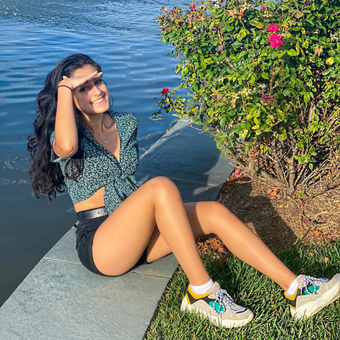
What I love most about biocomputational engineering is how much we can do with this degree!
The University of Maryland Biocomputational Engineering (BCE) senior Melina Khansari was always curious about the Universities at Shady Grove. After her older sister went there to earn a business degree and explained how small the classes were, Khansari decided to apply. "I am glad I did because now I am close to my classmates and professors; it feels like a big family," she said.
Since Khansari was six years old, she knew she wanted to be an engineer. She always loved biology and she later became interested in computer science. When she heard about the biocomputational engineering program, a mix between biology and computer science, she knew it would be the perfect fit for her.
"What I love most about biocomputational engineering is how much we can do with this degree! I can work as a lab researcher, a statistician, a developer, and in artificial intelligence (AI). I will be pursuing a career as a data analyst," Khansari said. She noted how grateful she is to have decided to major in biocomputational engineering because it taught her skills she would not have otherwise learned until graduate school, such as techniques in machine learning, AI, computer vision, and synthetic biology.
Recently, Khansari was one of 10 finalists for the poster competition at the 2022 Bioinformatics and Computational Biology Retreat at the University of Texas Southwestern Medical Center. The event featured graduates, postdoctoral researchers, professors, and others who presented projects in computational biology.
BCE Program Coordinator Emily Bailey encouraged all BCE students to apply for the poster competition, and Khansari decided to take a stab at it. "I was very surprised to have been selected as a finalist along with students from all over the U.S.," Khansari said. "I felt good presenting my poster because I was comfortable with my research since I had put in a lot of work for it, so I knew it well." Khansari explained her research centered on applications for predicting lung cancer patients' survival status. Her work involved the segmentation of tumors and coding to analyze the results using Python and R coding languages.
Khansari advises those pursuing a degree in biocomputational engineering not to worry if they don’t yet know much about coding, biology, or a given related subject. The biocomputational engineering program is designed to offer guidance in these areas, and the professors are supportive, she said.
Those interested in learning more about how to apply to the University of Maryland’s B.S. in Biocomputational Engineering degree program should set up a meeting with Emily Bailey. The program is now open to both freshman applicants – who would complete their first two years of undergraduate study at the University of Maryland, College Park – and transfer students – who enter directly into the program at the Shady Grove campus.
Top